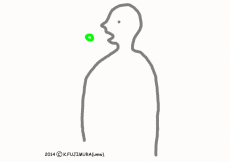[046] Digestion and metabolism (GB#105A02) | 基礎医学教育研究会(KIKKEN)Lab

● Digestion outside the body, metabolism in the body
Eaten are broken up into small units by digestion in the gastrointestinal tract and absorbed into the body from the surface of the tube. Beyond the cell membrane of the wall of the gastrointestinal tract will become “inside the body”, but digestion is a work to be done in the “outside world” in the gastrointestinal tract as preparation for absorption. Absorbed nutrients are withdrawn energy by metabolism in the body.
After that, quite roughly, in the form of carbon dioxide gas, water molecules and nitrogen compounds, that is, breath, urine, and sweat, it is thrown out again outside. Where is that poop? The substances making the feces are the leftovers that were not absorbed by the intestines and the debris of the cells that have changed the intestines (in addition, intestinal bacteria and their debris).
—
Contents
- 1 ● Nutrients are not absorbed unless they are digested
- 2 ● 3 types of nutrients to be digested
- 3 ● Carbohydrates that can be digested are limited
- 4 ● Carbon and lipid are energy masses
- 5 ● Protein has nitrogen
- 6 ● Digestive enzymes work in aqueous solution
- 7 ● Monosaccharides and amino acids move directly to the liver
- 8 ● Carbohydrates and fatty acids are accumulated or decomposed as needed
- 9 ● Amino acids turn into proteins and other substances
- 10 ● Absorbed nutrients get lost by dissipating energy
- 11 ● Nutrients after use are spilled out of the body in the form of residual slag
- 12 ○ Referenced sites
- 13 ○ Related articles
- 14 ○Referenced books
● Nutrients are not absorbed unless they are digested
Nutrients are not absorbed in the body as they are. The thing put in from the mouth is the product of another creature.There are lots of things that do not fit your body as it is. After all, even if the compound of the same nutrient is needed in the body, we do not do detailed things like getting in with special route as much. Once all nutrients are broken down into decomposed elements.Absorb with the element parts, reassemble the necessary things in the body again. On the other hand, if the substances that were in the body are swapped to each part in turn, they are further dispersed and energy is extracted and the debris is thrown out of the body. This is a very rough process of digestion, absorption and metabolism.
● 3 types of nutrients to be digested
![]() According to the “Nutrition Labeling Standard” set by the Japanese Ministry of Health, Labor and Welfare, nutrients are protein, lipid, carbohydrate, 13 kinds of inorganic salts and 13 kinds of vitamins. Among them, the first three are called three major nutrients. In order to be absorbed by the body, nutrients need to be decomposed and digested into the constituent unit components.
According to the “Nutrition Labeling Standard” set by the Japanese Ministry of Health, Labor and Welfare, nutrients are protein, lipid, carbohydrate, 13 kinds of inorganic salts and 13 kinds of vitamins. Among them, the first three are called three major nutrients. In order to be absorbed by the body, nutrients need to be decomposed and digested into the constituent unit components.
In other words, proteins are broken down into amino acids that are monomers, lipids are decomposed into glycerin and fatty acids, which are constituent parts, and carbohydrate is decomposed into monomeric monosaccharides. For each of the three nutrients, the mechanism of digestion is different, and further the mechanism of absorption and metabolism is different. Apart from small stories, it is important to keep that big flow down.
● Carbohydrates that can be digested are limited
Now, depending on the textbook in Japan, “sugar substance”, lipid, protein are cited as three major nutrients. But is sugar substance and carbohydrate the same? Sugar as nutrient is said to be carbohydrate in English translation, so it seems to be the same thing. However, it is stated in Japanese “Nutrition Labeling Standard” that “amount of carbohydrate” can be replaced with “amount of sugar substance and dietary fiber”. If so, in Japan it seems that “sugar substance” is regarded as a carbohydrate other than dietary fiber.
“Dietary fiber” is a term that collectively refers to carbohydrates that human digestive enzymes do not work and are not digested by human power. In Japan, carbohydrates that humans can digest are called “sugar substance”. Dare to express it in English, it seems to be “nutritional carbohydrate”.
Anyway, of carbohydrates entering human mouth, there are not many that can be digested. In polysaccharide, both starch and glycogen, which is a polymer of glucose, can be digested. In addition, only three types of disaccharide can be digested, sucrose, maltose, lactose.
Cellulose, which occupies about half of the dry weight of vegetables, is a substance making cell walls of plants, like carbohydrates like cousins of starch. However, humans do not have digestive enzymes that break down cellulose. Therefore, it can not be digested. However, part of dietary fiber is gaining attention at this time because intestinal bacteria that aid intestinal activity are digested. These are digested and decomposed by bacteria, absorbed as lactic acid, acetic acid, etc, so it seems that there is reasonable nutritional value.
● Carbon and lipid are energy masses
The carbohydrates and lipids are the same for the three kinds of carbon C, oxygen O, and hydrogen H. Carbohydrates have a large amount of oxygen and lipids have very little oxygen. The more important difference is that carbohydrates are more likely to contain water and lipids repel water due to the difference in elemental connection. Both are important as a mass of energy used in the body via adenosine triphosphate (ATP), but lipids of the same energy quantity are more suitable for storage because they are lighter than carbohydrates. Instead, carbohydrates are advantageous in that they are easier to extract energy than lipids. Relationship with water is totally different, there are also great differences in digestion and absorption methods when it is taken into the body.
● Protein has nitrogen
On the other hand, proteins are used as a material for creating new proteins in the body rather than as energy. Protein is a macromolecule made by joining together 20 kinds of amino acids in order of various combinations. Since each amino acid always has nitrogen N in addition to carbon, oxygen and hydrogen, the protein contains a large amount of nitrogen N. About 20 kinds of amino acids used for protein synthesis, about half can be made from other amino acids etc. However, the remaining half, nine can not be made in the human body, so it is called essential amino acids. “Essential” means that you must take it as a nutrient. Protein is familiar with water, so digestion and absorption methods are somewhat similar to carbohydrates.
● Digestive enzymes work in aqueous solution
![]() Starch and glycogen are mainly degraded into disaccharide maltose by digestive enzyme attack directly in the small intestine aqueous solution. After that, it is separated by enzymes on the surface of the cell membrane of the small intestine wall and becomes glucose, which is immediately incorporated into small intestinal epithelial cells. Since carbohydrates are repelled by phospholipid-made cell membranes, a dedicated carrier is required for uptake.
Starch and glycogen are mainly degraded into disaccharide maltose by digestive enzyme attack directly in the small intestine aqueous solution. After that, it is separated by enzymes on the surface of the cell membrane of the small intestine wall and becomes glucose, which is immediately incorporated into small intestinal epithelial cells. Since carbohydrates are repelled by phospholipid-made cell membranes, a dedicated carrier is required for uptake.
On the other hand, the digested lipid basically takes the form of neutral fats in which glycerin and a fatty acid are combined and decomposes in the aqueous solution of the small intestine also under the attack of digestive enzymes. However, since neutral fat repels water, digestion must be assisted by a bile that acts to improve the affinity of lipids and water for the enzyme to work. Instead, when in contact with the cell membrane, fatty acid and glycerin pass through the cell membrane with simple diffusion.
Proteins are first appropriately chopped with digestive enzymes in a strongly acidic aqueous solution of the stomach. After that, it is attacked by a new digestive enzyme in the small intestine, and it is broken down into a small peptide made of two to several amino acids. After that, it is eventually separated into individual amino acids on the cell membrane surface and is immediately absorbed into epithelial cells. Absorption of amino acids is similar to that of monosaccharides, carried by carriers dedicated to amino acids in the cell membrane.
● Monosaccharides and amino acids move directly to the liver
The monosaccharides and amino acids taken in the small intestinal epithelial cells pass through the back door of the cell as it is (there is also a dedicated carrier here), and it is picked up by capillary vessels running sideways. After that, it passes through the portal vein, reaches the liver, where it is processed. ![]()
Meanwhile, glycerin and fatty acid taken in the cell are reconstituted as new neutral fat in the cell, and this time it is packed as chylomicron, and it escapes from the back of the cell. Basically, chylomicrons are picked up by capillary lymphatic vessels, concentrated in the lymphatic system and join the vena cava by the heart, so they do not pass through the liver, go through the systemic circulation through pulmonary circulation. I do not fully understand what it means. Anyway, around the tissue that needs lipid, various lipids including chylomicron after exchanging with cells are finally handled around the liver and processed. Small fatty acids not entering chylomicron are said to move directly from the capillary to the liver。
● Carbohydrates and fatty acids are accumulated or decomposed as needed
A part of glucose which occupies most of the monosaccharides flowing through the blood is used as it is as the sole energy source of brains and blood cells (erythrocyte). The remaining part is taken into the liver and muscle cells, and as glycogen, if it has room, it is taken into adipose tissue and turns into neutral fat, and it accumulates as an inventory of energy source until it becomes necessary. Lipids flowing through the blood are used as energy sources for the muscles and the heart that are always putting strength, and if this is also affordable, it accumulates as neutral fat with adipose tissue as it is. As with the carbohydrates, surplus amino acids are converted into fatty acids and accumulated in the liver.
The time when you are hungry between meals and meals uses the stored glycogen and neutral fats in order. ![]() However, muscle glycogen is used by the muscle itself, whereas the liver does not use glycogen as its own energy source. Because liver glycogen is a source of glucose needed for brain activity. The liver itself takes out the necessary energy using fatty acids and amino acids while conducting very complicated metabolic activities whether it is meal or hungry.
However, muscle glycogen is used by the muscle itself, whereas the liver does not use glycogen as its own energy source. Because liver glycogen is a source of glucose needed for brain activity. The liver itself takes out the necessary energy using fatty acids and amino acids while conducting very complicated metabolic activities whether it is meal or hungry.
● Amino acids turn into proteins and other substances
Amino acids are taken up by cells of the whole body and used as a material of proteins to maintain cell functions such as the skeleton of each cell and enzymes and receptors. Especially in the muscle a large amount of protein for muscle contraction such as actin and myosin is made. In the liver, we make various plasma proteins including albumin. Although it is not limited to protein, any substance of the body is made, while it is being destroyed more and more. Proteins are also returned to each amino acid again. Compounds containing nitrogen N, including surplus amino acids, can be converted to substances for excretion such as urea, ultimately by extracting energy, converting to sugar or fat, through liver metabolism.
● Absorbed nutrients get lost by dissipating energy
The source material from which energy is extracted has a basic structure of carbon and hydrogen skeletons. The simplest structure is methane (CH4), which is not a constituent of the human body, but if you apply oxygen it burns and burns (explodes). It radiates energy. As a result, water without energy H2O and carbon dioxide CO2 is completed.
CH4 + 2O2 -> CO2 + 2H2O + energy
The metabolism of the human body, in short, is the same.The representative monosaccharide of energy source is C6H12O6, and oxygen is partially bound from the beginning. And because it is not a gas, it is easy to handle. In the body, the work to extract energy is carried out gradually so that it does not explode at once.
C6H12O6 + 6O2 -> 6CO2 + 6H2O + energy
As well as neutral fat, when amino acids are stripped of nitrogen, eventually it will become water and carbon dioxide if energy is extracted. Nitrogen does not leave the body with the form of gas. Unlike carbon dioxide, the amount of nitrogen gas that occupies about 80% of the air is too large and it is difficult to excrete.
● Nutrients after use are spilled out of the body in the form of residual slag
In other words, after eating rice, bread and meat lumps, the contents of the feces coming out of the body, apart from water accounting for 80%, are mostly dietary fiber and enterobacteria, such as intestinal bacteria which were not originally absorbed materials. One third of the mass seems to be a remnant of cells detached from the intestinal wall. The water of stool is about 4% of the water exhaled from the body, in other words, the masses coming out of the large intestine are mostly not decomposition metabolized in the body.  Nutrients used for the body disappears as energy such as carbon dioxide discharged from the mouth and urine and perspiration after it is extracted. The source of urine nitrogen compounds is protein nitrogen. Energy is used as a driving force to synthesize, destroy or move substances of the body, but eventually it escapes from the surface of the body while maintaining body temperature as heat.
Nutrients used for the body disappears as energy such as carbon dioxide discharged from the mouth and urine and perspiration after it is extracted. The source of urine nitrogen compounds is protein nitrogen. Energy is used as a driving force to synthesize, destroy or move substances of the body, but eventually it escapes from the surface of the body while maintaining body temperature as heat.![]()
Aside from the period of growth from children to adults, the incoming coming out, so there is nothing left in the end. Even though the life that was born originally grew, it surely disappears by the end. The preciousness of life seems to be in the process of exchanging matter and energy itself, which never stops moving during that process. On that basis, “culture” and “information” may be produced from a part of the energy consumed by humans, but unfortunately we do not know how to estimate it.
○ Referenced sites
・Nutrition labeling standard (Notification No. 176 of Ministry of Health, Labor and Welfare, 2003) – Consumer Agency
・Enteral nutrition, clinical nutrition understood by keyword, Newtory Co., Ltd.
・Urea circuit, medicine of lipid and thrombus
・Pooch is made of what, how to know the intestinal environment from poo, Taiho Pharmaceutical
○ Related articles
◆[022] 胃と十二指腸 the stomach and the duodenum ![]()
◆[054] Switching of the airway and esophagus (GB#105A04)![]()
◆[013] 細胞膜の脂質二重層 lipid bilayer of the cell membrane ![]()
◆[007] ブドウ糖と,ショ糖の加水分解 glucose and the hydrolysis of sucrose ![]()
◆[017] 糖質の吸収 absorption of carbohydratel ![]()
◆[027] ペプチド結合 peptide bond ![]()
◆[032] グリコーゲンの合成 glycogen synthesis ![]()
◆[047] glycolysis ![]()
◆[042] TCA回路 TCA cycle ![]()
◆[019] アデノシン三リン酸(ATP) adenosine triphosphate ![]()
◆[050] Cellular respiration ![]()
◆[038] Homeostasis of the core body temperature ![]()
◆[001] Heartbeat pumping ![]()
◆[016] 血液循環 blood circulation ![]()
◆[035] 骨格筋収縮の張力 tension of the skeletal muscle contraction ![]()
◆[026] interaction of myosin and actin ![]()
◆[040] シナプス伝達 neural signal transmission ![]()
◆[003] Diaphragmatic breathing ![]()
◆[015] 胸式呼吸 costal breathing ![]()
◆[010] 肺胞換気量と死腔 alveolar ventilation and dead space ![]()
◆[023] 赤血球とヘモグロビン erythrocyte and hemoglobin ![]()
◆[011] 体内の酸性・アルカリ性と炭酸ガス body acid-base reaction and carbon dioxide gas ![]()
◆[043] 糸球体のろ過 glomerular filtration ![]()
○Referenced books
・Lehninger Principles of Biochemistry 6th, International Edition, Macmillan Higher Education, England.
・Essential細胞生物学〈DVD付〉原書第3版,南江堂
・カラー版 ボロン ブールペープ 「生理学」, 西村書店
・カラー図解 人体の正常構造と機能 全10巻縮刷版,坂井 建雄,日本医事新報社
・トートラ人体解剖生理学 原書8版,丸善
・柔道整復学校協会編「生理学」,南江堂
・東洋療法学校協会編「生理学」,医歯薬出版株式会社
rev.20140114,rev.20140115,
rev.20151225,rev.20160123, rev.20170506, rev.20170520,rev.20180709.








